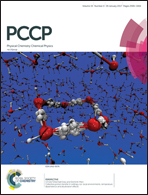Halogen bonding versus hydrogen bonding induced 2D self-assembled nanostructures at the liquid–solid interface revealed by STM†
Abstract
We design a bifunctional molecule (5-bromo-2-hexadecyloxy-benzoic acid, 5-BHBA) with a bromine atom and a carboxyl group and its two-dimensional self-assembly is experimentally and theoretically investigated by using scanning tunneling microscopy (STM) and density functional theory (DFT) calculations. The supramolecular self-organization of 5-BHBA in two different solvents (1-octanoic acid and n-hexadecane) at the liquid–solid interface at different solution concentrations is obviously different due to the cooperative and competitive intermolecular halogen and hydrogen bonds. Three kinds of nanoarchitectures composed of dimers, trimers and tetramers are formed at the 1-octanoic acid/graphite interface based on –COOH⋯HOOC–, triangular C![[double bond, length as m-dash]](https://www.rsc.org/images/entities/char_e001.gif) O⋯Br⋯H–C, –Br⋯O(H), Br⋯Br, and O⋯H interactions. Furthermore, by using n-hexadecane as the solvent, two kinds of self-assembled linear patterns can be observed due to the coadsorption, in which the dimers are formed by intermolecular –COOH⋯HOOC– hydrogen bonds. The molecule–solvent and solvent–solvent van der Waals force and intermolecular hydrogen bonds dominate the formation of coadsorbed patterns. We propose that the cooperative and competitive halogen and hydrogen bonds are related to the polarity of the solvent and the type of molecule–solvent interaction. The intermolecular binding energy of different dimers and their stability are supported by theoretical calculations. The result provides a new and innovative insight to induce the 2D self-assembled nanostructures by halogen and hydrogen bonds at the liquid–solid interface.
O⋯Br⋯H–C, –Br⋯O(H), Br⋯Br, and O⋯H interactions. Furthermore, by using n-hexadecane as the solvent, two kinds of self-assembled linear patterns can be observed due to the coadsorption, in which the dimers are formed by intermolecular –COOH⋯HOOC– hydrogen bonds. The molecule–solvent and solvent–solvent van der Waals force and intermolecular hydrogen bonds dominate the formation of coadsorbed patterns. We propose that the cooperative and competitive halogen and hydrogen bonds are related to the polarity of the solvent and the type of molecule–solvent interaction. The intermolecular binding energy of different dimers and their stability are supported by theoretical calculations. The result provides a new and innovative insight to induce the 2D self-assembled nanostructures by halogen and hydrogen bonds at the liquid–solid interface.



 Please wait while we load your content...
Please wait while we load your content...